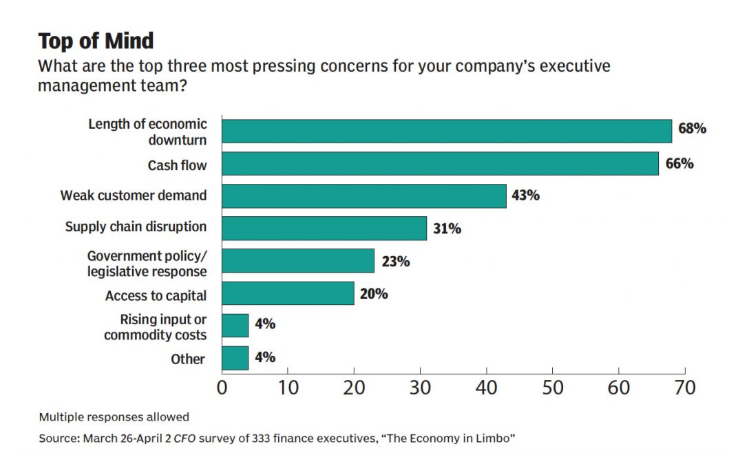Three months ago, we could not have imagined life as it is today. We’re experiencing an economic slowdown that none of us have seen before. Not a single industry is immune from the impact of the U.S. and other countries sheltering-in. Many businesses and industries are down, decimated and are temporarily or permanently closed. Others, like those in the streaming and video conferencing industries, online grocery shopping and third-party restaurant delivery services are booming.
This volatility puts tremendous pressure – both in the form of threats and opportunities – on the CFO and the Office of Finance. There are many questions facing the CFO. Let’s take a look at what some recent reports indicate, and how CFOs and the Office of Finance can arm themselves to be better positioned to respond to both the threats and the opportunities presented by today’s market.
CFOs’ Concerns
CFOs are concerned with the potential length of this downturn. CFO surveyed financial executives and found that they are taking immediate financial action to “survive revenue and profit impacts.” More than half of these executives are estimating a drop in sales between 1 – 20% in the first quarter of 2020. But on a positive note, 46% said they expected a “V-shaped recovery.”

McKinsey & Company recently wrote about The CFO’s Role in Helping Companies Navigate the Coronavirus Crisis. In it, they state,
“The CFO can play a strong, central role, alongside executive peers, in stabilizing the business and positioning it to thrive when conditions improve … The CFO is the leader, after all, who most directly contributes to a company’s financial health and organizational resilience day to day.”
CFO reports their second concern was cash flow. This is critical, but not unmanageable. This is where the Office of Finance plays a central role in helping the organization survive. Your 2020 budget, plan, and forecast are all irrelevant now. You need to adjust your forecast to give an accurate financial outlook to senior management and investors. Your forecast must reflect new operational metrics for changes in production facilities, staffing and purchasing. It is imperative to change your forecast to show long-term plans for banks and other lenders.
To do that you need to understand what your business model looks like now. Not what it did when you put together your original FY2020 forecast. But what it looks like today, with schools, malls and restaurants closed, production lines stopped or transformed into making PPE, shipments delayed, and vital parts of our supply chains overwhelmed.
Do you have an accurate understanding of your model? The time to act is now. The business environment is uncertain now, and it’s impossible to predict what the next few quarters will look like – regardless of your industry, size, or location.
